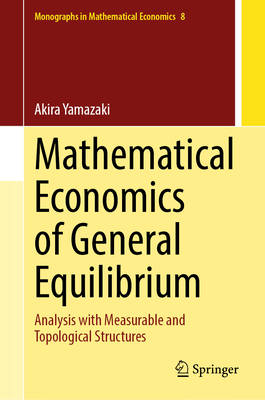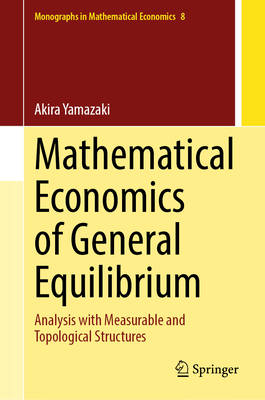
- Afhalen na 1 uur in een winkel met voorraad
- Gratis thuislevering in België vanaf € 30
- Ruim aanbod met 7 miljoen producten
- Afhalen na 1 uur in een winkel met voorraad
- Gratis thuislevering in België vanaf € 30
- Ruim aanbod met 7 miljoen producten
Zoeken
Mathematical Economics of General Equilibrium
Analysis with Measurable and Topological Structures
Akira Yamazaki
€ 152,95
+ 305 punten
Omschrijving
This book presents a rigorous formulation of the general equilibrium model in economies with topological and measurable mathematical structures. It aims to provide basic tools and analytical methods for advanced graduate students and researchers interested in microeconomic theory and game theory. It is based on lecture notes distributed among advanced graduate students in the advanced mathematical economics course at the Ph.D. level. The book presents a unified treatment of the general equilibrium analysis of economies with perfectly competitive markets based on the Walrasian model. It is divided into Part I and Part II. The mathematical analysis of general equilibrium in perfectly competitive economies begins in Part II. As a mathematical preparation for Part II for most economics students, Part I collects some basic mathematical concepts and facts that are later needed and used in the theoretical economic analysis. Some readers may wish to start the book from Part II and refer back to Part I whenever it is necessary to review mathematical concepts and related well-known mathematical results referred to in the text. The presentation of theoretical economic analysis of general equilibrium theory in Part II is organized chapter by chapter: Basic Concepts of Equilibrium Analysis, Mathematical Structure on the Space of Economic Agents' Characteristics, Individual Demands, Economies with a Measure Space of Consumers, Walrasian Equilibria of Economies, Production Economies, and Edgeworth Equilibria as the Core of Economies. The mathematical analysis in this book uses topological and measurable structures that are essentially built into the model to provide an appropriate means of expressing the characteristics of economic agents that form a basic part of economies along with commodities in market transactions and market prices for valuation in markets.
Specificaties
Betrokkenen
- Auteur(s):
- Uitgeverij:
Inhoud
- Aantal bladzijden:
- 236
- Taal:
- Engels
- Reeks:
- Reeksnummer:
- nr. 8
Eigenschappen
- Productcode (EAN):
- 9789819694969
- Verschijningsdatum:
- 12/10/2025
- Uitvoering:
- Hardcover
- Formaat:
- Genaaid
- Afmetingen:
- 156 mm x 234 mm
- Gewicht:
- 526 g

Alleen bij Standaard Boekhandel
+ 305 punten op je klantenkaart van Standaard Boekhandel
Beoordelingen
We publiceren alleen reviews die voldoen aan de voorwaarden voor reviews. Bekijk onze voorwaarden voor reviews.








